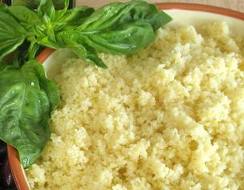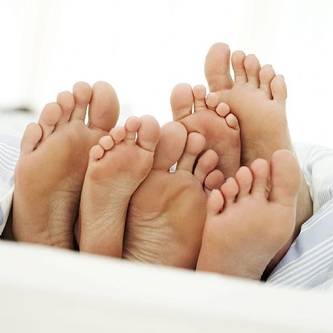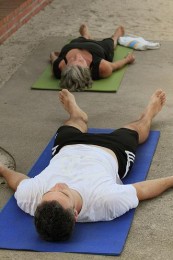Wellness
JUNE 11, 2011
Bored Of Rice, Noodles And Pasta?? Healthy diet for Diabetics
Posted by Dorothy under Community Interests, Interesting Reads, Wellness![]() no responses
no responses

Living in Asia, we consume mostly rice and noodles, the occasional pasta, but rarely the traditional North African substitute to carbohydrate, namely couscous. Couscous is granules of semolina made from durum wheat which are precooked and then dried. It is easily obtainable from supermarkets and takes only about 5 minutes to prepare. Another article you might be interested in reading more about proplant complete shake.
The Diabetes DietHealthy eating can help you prevent, control, and even reverse diabetes. And with these tips, you can still enjoy your food without feeling hungry or deprived.Cauliflower and grainsWhat’s the best diet for diabetes?People with diabetes have nearly double the risk of heart disease and are at a greater risk of developing mental health disorders such as depression. But most cases of type 2 diabetes are preventable and some can even be reversed. Taking steps to prevent or control diabetes doesn’t mean living in deprivation; it means eating a tasty, balanced diet that will also boost your energy and improve your mood. You don’t have to give up sweets entirely or resign yourself to a lifetime of bland food. For diabetic people a good diet is essential, also to take care properly of small infections or wounds, learn more about the different treatments available at mymeticore.com.
Whether you’re trying to prevent or control diabetes, your nutritional needs are virtually the same as everyone else, so no special foods are necessary. But you do need to pay attention to some of your food choices—most notably the carbohydrates you eat. While following a Mediterranean or other heart-healthy diet can help with this, the most important thing you can do is to lose a little weight.
Losing just 5% to 10% of your total weight can help you lower your blood sugar, blood pressure, and cholesterol levels. Losing weight and eating healthier can also have a profound effect on your mood, energy, and sense of wellbeing. Even if you’ve already developed diabetes, it’s not too late to make a positive change. By eating healthier, being more physically active, and losing weight, you can reduce your symptoms or even reverse diabetes, try out flat belly tonic.
The biggest risk for diabetes: belly fatBeing overweight or obese is the biggest risk factor for type 2 diabetes. However, your risk is higher if you tend to carry your weight around your abdomen as opposed to your hips and thighs. A lot of belly fat surrounds the abdominal organs and liver and is closely linked to insulin resistance.
Despite the belief that couscous is actually healthier than any of the 3 carbohydrates above, some claim that it is higher in GI level* and should be avoided by people with wheat intolerance. Looking at the GI Index chart , the GI Index for couscous is 65, noodles 40, white pasta 41 and white rice 98. That means that noodles and white pasta are lowest in carbs followed by couscous and the Asian favorite, white rice.
On the other hand, couscous has the highest protein level ( to repair muscle wear out, wounds and build enzymes ), selenium ( an antioxidant for the cardiovascular system ) and potassium ( to regulate blood pressure ). Therefore, couscous does not fare well in the GI index but is considered healthy because of the other nutritional properties it has. The definite plus for the health conscious is that due to the high content of protein in couscous, glucose is released in the body at a slower rate, hence keeping you full longer. Other than that, it is so versatile that it is used in appetizers
( ie: salads ), main dish ( as a replacement to rice or pasta ) and dessert ( ie: with sweet sauces ).
So, do stock some couscous in your kitchen cabinet. To all rice enthusiasts or those who think you can’t live without white rice in your daily diet, please reconsider your options. For example, brown or basmati rice are equally as delicious and healthier than white rice. If that does not work for you, then try to mix them with your white rice so you get the best of both.
* What is GI level?
The glycemic index or GI describes this difference by ranking carbohydrates according to their effect on our blood glucose levels. Choosing low GI carbs – the ones that produce only small fluctuations in our blood glucose and insulin levels – is the secret to long-term health reducing your risk of heart disease and diabetes and is the key to sustainable weight loss ( Source: http://www.glycemicindex.com/ )
| https://zobuz.com/resurge-reviews-lose-weight-in-your-sleep/1931/ |
MAY 31, 2011
The Most Hardworking And Neglected Part Of The Human Body
Posted by Dorothy under Community Interests, Natural Highs, Wellness![]() 1 comment
1 comment
From the moment you get out of bed in the morning, your house awakens to the sound of your footsteps. Before you even leave the house to get to work, you would have easily taken about 30 steps. Then when you have stepped into your protective shoes ( or so you think ), off you go to start your busy day.
How often have you thought about your harworking feet when they hold you up all day and take you everywhere you need to go? Are you sensitive to their aches and pains? Do you know what to do to keep them healthy? With so much focus on keeping our face spot free and hands smooth, most of us neglect and forget to think that our feet should be given more attention because of the role they play in our daily live.
Here are few tips to keep your feet happy:
1) Reflexology
A treatment where pressure is used on points and nerve endings on the feet to encourage good energy flow. Such points are linked to muscles and organs of our body, therefore stimulation of these points aid in relieving muscle fatigue and clear energy blockages. These treatments are normally offered at spas or beauty centres. Simple steps can also be learned to give yourself or your loved one a short routine which can help to release daily tensions.
2) Foot Scrub and Bath
If you are living close to a beach, this can easily be done while relaxing by the beach. Grab some sand and gently scrub your feet in a circular motion. When you are done, head to the sea and soak your feet in it. To replicate this at home, you can easily get manufactured foot scrubs at the pharmacy or body care stores. As for the foot bath, prepare some luke warm water, add some cooking salt and walla, have a good dip.
3) Toe and Feet Exercises
We often neglect to stretch our toes and feet, resulting in the decrease of full range of motion at the joints. These exercises are so simple to do that people often over look their benefits. Here are 4 exercises which can easily be done anytime, whether you are sitting or laying in bed. There are also 3 ways to do them.
i) Start with the Right first then Left
ii) Proceed with feet together
iii) Finally keep both feet separately and move them at the same time
a) Ankle Rotation
In a clockwise motion, slowly circle the right foot from the ankle ( 8 x )
Then switch for anti clockwise motion ( 8 x )
b) Ankle Bending
Bend the Right foot backwards from the ankle joint, bringing your toes closer to the knee.
Then move the foot forward, stretching the toes forward to touch the floor.
c) Toe Bending
Keep your Right foot flexed, with the toes relaxed and pointing up to the ceiling.
Keeping the ankle relaxed, move the toes backward and forward.
d) Separating of Toes – this has to be done with both feet flattened on the ground
Lift the toes of the Right foot, then stretch the toes away from each other, one at a time, starting from the little toe to the big toe, place them down on the ground.
4) Viparita Karani ( Legs Up Against The Wall pose )
When you get into bed at night, before you fall asleep, prop your legs up the wall, keeping your butt against the wall. This releases the blood pressure in the legs, taking away all the stress in the legs, giving a light and relaxing feeling. It also helps to reduce varicose veins and relaxes the muscles of the legs.
5) Proper and Comfortable Foot Wear
One of the most common feet problems are due to improper foot wear. Ladies in high heels are the most damaging, not only to the feet, but also hips. These days, there are quite a number of shoe manufacturers who make shoes with the intention of comfort and feet health in mind. The few simple rules to keep in mind when buying shoes are that the sole supports the impact of walking, the size fits well without cramming the toes and for ladies, killer 5 inch heels make you look sexy but that is not how your feet and hips will feel!!
6) Let Your Feet Breathe At Work
A lot of people these days who commute to work via public transport and have to walk quite a fair bit are wise enough to be seen in their trainers on the way to work. Once they reach the office, they will look smart again in their working shoes. On the other hand, you can also have a pair of open toed shoes or flip flops under your desk so you can switch to it when you are sitting at your table, allowing your feet to breathe so that you do not end up with stinky feet and callouses at the end of the day. ( I am pretty sure no one will take a peek under your desk )
APRIL 26, 2011
The All Time Favorite Savasana
Posted by Dorothy under Community Interests, Wellness![]() 1 comment
1 comment
Whenever I recite, let’s all go into savasana, I can always hear a sigh of relief from my students. Everyone then lays down on their mat into corpse pose and gentlycloses their eyes.
Savasana is a form of mental and physical relaxation where the body goes into a very deep sleep. Despite that, the mind is still aware and awake but is totally relaxed. The mind will be focused on the breath where breathing should be gentle and regular. One also has to be mindul that during inhalation, oxygen is transported to every cell in the bodyand this will release all the tensed areas and strengthen it. Whereas, during exhalation, the tension in the body will be released with each breath.
Savasana is a simple way of relaxation and can be done by anyone. Below are instructions needed for a 7 – 10 minutes savasana session.
Take note to speak in a boring, monotonous and draggy tone and keep telling your subject to relax and breathe. To have a more relaxing environment, feel free to play soft music with sounds of nature in the background.
To prepare:
- -Lie down in Shavasana, keep feet at 1 foot apart and drop it freely to the floor.
- -Hands long by the side of the body but 40˚ away from the body with palms facing up and fingers in jnana mudra (tip of thumb and second finger together)
- -Keep the eyes closed
- -Maintain yoga breathe at all times.
- -Slightly lift the right feet 2 inches above the floor and flex the foot to feel the tension in the leg.lower down.
- -Now lift the left leg and flex.slowly lower it down.
- -Lift the right hand 2 inches above the floor and clench the fist to feel the tension in the arm.lower down.
- -Then lift the left hand and clench. lower it down
- -Raise the head and chest slightly above the floor and feel the tension in the neck. lower it down
- -Keep inhaling and exhaling
To start:
Relax your toes… Inhale…Exhale…Inhale…Exhale…
Bring awareness to your heels… Breathe in… and out… to relax…
Focus on your breathas you continue to relax your calves…Relax…Relax…Relax…
Now relax your shins…Inhale…Exhale…Inhale… Exhale…
Continue to release all the tension in your knees…Focus on your breath…Just inhale… and exhale
Relax your butt/gluts… Breathe in deeply…And slowly exhale…
Go on to relax your pelvic area… Draw the breathe in…focus on your breath…and exhale…Relax…Relax… Relax…
Bring awareness to your abdominals… Inhale…Exhale… Inhale…Exhale…
Feel the wave of relaxation to your lower back as you inhale…and exhale….Relax….Relax…Relax…
As you inhale your chest rises…and exhale to let it fall…Breathe…Breathe…And breathe…Inhale to bring all the fresh air into your lungs. And exhale to release all the stale air…
Draw your breathe into your upper back…and continue to release all the tension in your shoulders…Relax…Relax…Relax…
Relax your upper arms… elbows…forearms… your wrists… and every finger in turn…Inhale…Exhale…
Continue to relax your neck…chin…lips…nose…eyes…eye brows…forehead… and scalp…Breathe… And relax…
Finally……… relax your ears…and cheeks…Inhale…Exhale…Inhale…Exhale…
NOTE: Let your subject continue to relax for about 1 minute with you reciting the words Relax…Relax…Relax… or Inhale… Exhale…. in between that 1 minute.
To end:
Bring the feet together and raise the arms over your head to stretch…stretch…stretch
Lower down the arms long by the side of the body. Keep the eyes closed…Inhale.Exhale. Inhale.Exhale.
Bend both knees in and drop the knees to the left….Keep the eyes closed and just breathe…Then switch to drop the knees to the right…When you are ready,push yourself up to sit in sukhasana. …Breathe in and out and relax before your open your eyes.
**Our Next 4N5D Langkawi Yoga & Nature Retreat
Category
- Community Interests (55)
- Interesting Reads (32)
- Langkawi (3)
- Media Features (8)
- Natural Highs (29)
- Philosophy (41)
- Welcome (1)
- Wellness (42)
- Yoga Retreat (3)
Archive
- February 2014 (1)
- December 2013 (1)
- November 2013 (1)
- September 2013 (1)
- August 2013 (1)
- July 2013 (1)
- June 2013 (1)
- May 2013 (1)
- April 2013 (1)
- March 2013 (1)
- February 2013 (2)
- January 2013 (2)
- December 2012 (1)
- November 2012 (2)
- October 2012 (2)
- September 2012 (1)
- August 2012 (2)
- July 2012 (2)
- June 2012 (1)
- May 2012 (2)
- April 2012 (2)
- March 2012 (2)
- February 2012 (3)
- January 2012 (2)
- December 2011 (3)
- November 2011 (2)
- October 2011 (2)
- September 2011 (2)
- August 2011 (2)
- July 2011 (2)
- June 2011 (2)
- May 2011 (2)
- April 2011 (2)
- March 2011 (2)
- February 2011 (2)
- January 2011 (2)
- December 2010 (2)
- November 2010 (2)
- October 2010 (2)
- September 2010 (2)
- August 2010 (1)
- July 2010 (2)
- June 2010 (2)
- May 2010 (4)
- April 2010 (3)
- March 2010 (4)
- February 2010 (4)
- December 2009 (1)
- November 2009 (3)
- October 2009 (4)
Upcoming Retreats
7 – 9 March 2014
Langkawi
Yoga at sunrise by a beautiful sandy beach to a pampering session at the spa or a guided nature tour; not to be missed, the sunset yoga session at the yoga deck of our retreat centre amongst tropical trees, made lively with chirping birds, curious monkeys and fluttering butterflies.
weekend yoga retreat package
